|
|
Personal Projects
|
|
|
Last December I wrote a post on survival games, within we looked at the ingredients that make up this genre and discussed how games were using the equation in different ways. We discussed The Long Dark, No Man’s Sky, Don’t Starve, and We Happy Few. I’ve been playing three new survival games and thought it would be interesting to revisit this topic and dig a little deeper into it. Today I’ll be discussing The Forest, Rust, and The Flame in the Flood. There’s not going to be any major spoiler territory here, especially since two of these games are still in early access. The Forest is a first person, open world survival game. It’s still in early access and so what I say here may not be the same when the game finally gets it’s release. In the first moments of The Forest, you find yourself surviving a plane crash and waking up in the aft section of an airplane torn in two. You’re immediately introduced to your main resource management areas: hunger, hydration, health, and exhaustion… as they are all initially very low. Yet there’s a lot to scavenge nearby and the player can find themselves on their way fairly quickly. The Forest onboard’s it’s players fairly quickly with an intuitive controls and un-intrusive hints to the player. The player soon finds themselves exploring a densely thick forest, scavenging for supplies, clues to what happened to fellow passengers, and avoiding enemies. Honestly there’s a lot that could be discussed when it comes to The Forest, the intuitive AI, unnerving cannibals, etc… Yet what what really stuck out as it’s strongest pillar was it’s crafting system, which isn’t to say that the other areas weren’t strong… this game is doing a lot of things right… but as I’ve been playing many survival games I found the inventory management and crafting system with the Forest to be really innovative.
first person view. This will grant the player a “ghost vision” of the object until it’s constructed. What I also found interesting was that as you found resources to contribute to your construction, you see pieces being added onto your building until it’s completed. It’s also worth noting is that cutting down trees in The Forest is probably the most satisfying experience I’ve ever had for chopping down trees in a video game. It’s odd to think about how much time players have probably spent chopping down trees in various video games… In The Forest as you chop away at the tree you start to see where you’re striking and once you’re through, the tree actually falls in the most satisfying way. Your inventory is treated in a realistic and similar way, when you open it you see your backpack and an open tarp with all of your items. In this way it’s really neat to see all of your items laid out in front of you… although I could potentially see this as being overwhelming once you have a lot of items stored. I’ve already had a few instances where I had a hard time finding something, yet it felt no different than when I search my own bags for something that I know is there. To craft/upgrade items you place them on the center matt, at times this can be a bit of trial and error, as you place ingredients on the matt hoping that they’ll combine. My only complaint might be to allow the players to understand more of what ingredients are required for certain upgrades, yet I still didn’t feel frustrated by the experience overall. The true icing on this features is that when you’re choosing to upgrade an item, like an axe with a feather (which increases attack speed), you can then place the feather on the axe exactly where you want. I do not mean that it has specific slots to place items, the player is allowed to rotate around the item and place the added object wherever they want. This level of customization allows for high level of player ownership and investment into what they are doing. There are so many additional layers to The Forest and I’ve only begun to creep through them all. While survival is definitely always on the player’s mind, I found myself coming at it completely from a builder’s point of view. If I craft this wall I’ll be safe, if I improve my axe I’ll be more efficient, if I build a drying rack I’ll be able to store more food for longer, etc. The Forest is definitely a game that continues to surprise me and while I’m excited to explore this game more thoroughly… I’m also terrified at what it will throw at me next. If you haven’t yet, pick this game up! I also recommend playing this game coop, I found it really adds to the overall experience. Rust is a game that is only similar conceptually, but completely different in execution. Rust is the equivalent to an MMO version of a survival game. While it’s still in early access, Rust thrusts players into a procedurally populated world. Players are concerned with very typical resource management areas; i.e. Health, Hunger, Hydration. There are some minor additional elements to be concerned about, being wet, cold, etc, but mainly the player is faced with the main resources. The dynamic that makes Rust completely different than other survival games is it’s community. Within Rust you can randomly bump into other players on the server, who can easily murder you and take your stuff. When you log off, your character remains in the world… sleeping and vulnerable to anyone passing by. The social drama within Rust is what quickly becomes it’s main driving factor. Rust can feel more like a social experiment, than a survival game. When you create a new character in Rust, you are assigned a random gender and ethnicity… I also believe that your physique is also randomly generated. You start the game naked, with a torch and a rock and you have to survive. Seeing naked people running around in Rust is a pretty typical dynamic to the game. Within my first moments, it was easy to see that social dynamics were paramount to the game’s driving factors. I quickly stumbled upon a naked woman talking to a naked man, and as I approached I could hear a voice chat between two indian men. They were having an argument in which one person was accusing the other of attacking and stealing items from their home. “We had a peace treaty! Why would you do such a thing?” was stated at one point during the conversation… I can honestly say that within my recent run at survival games, no others had these types of ideas or moral concerns. A lot of my play experience settled around building a shelter, trying to fortify it before logging off… and inevitably by the time I’d log back in, my shelter would be ransacked and my character either looted or murdered. In one playthrough I actually found out that I had a neighbor and tried to befriend them. Even venting about having just been murdered and the murderer trying to steal my home. Upon logging in next time into the game, I found the neighbor not only killed me and ransacked my house… but left a picture on my wall that read “LOL.” It was a bit disheartening. Interesting social dynamics to the side, I generally found the inventory management and crafting systems to be a bit confusing. While Rust does provide more information on how to craft specific items than The Forest, there are many elements that are hard to figure out initially. For example knowing that you have to use wood to first craft paper, and then use the paper to craft a “building plan.” The Building plan then acts like a tool, allowing the players to place specific building pieces… yet you have to hold the right mouse button to open a radial wheel, which then shows you the options of what to build. From this radial menu, you might expect that if you highlight an item to select it, but you actually have to left click on the item you’d like to build… It’s really not intuitive and I am guilty of often mis-clicking. Once you have your first structure down, you then have to create a wooden mallet and use this to upgrade pieces of your new shelter. This uses the same right click radial wheel structure for players to select the level of upgrade they are looking for. Yet as you hover over pieces of your home, it’ll look highlighted in red… often leading to the misconception that you cannot upgrade, which isn’t always the case. I also find the classification of objects to be really confusing. I would not expect to find sleeping bags, a furnace, and a fish trap to all be under the same “Items” tab… these things just don’t fit with one another. Rust is both interesting and incredibly harsh due to the social dynamics of the game. My problems with the controls and UI aside, the ability to interact with other players provide unique and interesting scenarios. After getting killed so often, it’s easy to feel justified doing the same to others on your travels. That being said, unless you have a good group of people to play with, the game can easily become frustrating and uninteresting to play. It often feels like you’re building a sandcastle, only to have someone come kick it over when you’re not looking. In an effort to diversity my review of survival games, I thought I’d give The Flame in the Flood a chance. This is a pretty interesting game for both it’s decidedly different artistic direction, but also it’s unique outlook on a survival game. You start the game as a young girl, with a dog who finds her. What happens next finds the player traveling down river on a raft, looking for resources, safety, and potentially other survivors. The Flame in the Flood exists, in what I can only assume, is a semi-post apocalyptic world where most of the land is flooded. The player is presented with pretty standard resource management mechanics; Hunger, Hydration, Fatigue, and Health. The player is challenged with navigating hazards on the river and finding spots where they can go ashore and look for items to aid in their survival. Much like The Forest, the player has a book that offers them information on crafting, their stats, and quests. For me the main difference in The Flame in the Flood is the nomadic nature of the game mechanics. In so many other survival games, I believe it’s instinctual for a player to make a “home” for themselves and stay put. Even when I know I shouldn’t, I always try to make a fortified home in any survival game… and try to survive. Yet within The Flame in the Flood, you’re forced to be constantly moving down river. I believe that resource do not respawn in a certain area, and even if they did… most areas do not have many resources to begin with. The point of the game is to travel down river, and if anything your raft is your home. By forcing travel onto the player and coupling it with an neo-folk soundtrack really lends itself well to the feeling of being on a road trip… or some indie movie. In many times the game made me think of The Road, the general feeling of continually moving forward through a harsh landscape. The only other notable difference between this game, and others I’ve played lately, is having to unlock tiers within the crafting tree. In most other survival games you’re only ever restricted by the lack of tools you may have at any given time, not an actual quest objective. Within The Flame and the Flood, they limit their users to the recipes available to them until they’ve unlocked specific objectives or waypoints. I found this just to be a bit annoying, in an otherwise fantastic experience. The general sense of progression, going down river, upgrading your tools and your raft… is very rewarding. I’m excited to explore this game further as I accidentally ruined my save while trying to do research for this very post… so I’ll be starting over once I finish. I’ve been really struggling to find a good way of truly illustrating the difference between survival games in a quantitative way. I have a lot of opinions on the difference between these games, and what pillars I believe they rest on, but I wanted to find more data to base my conclusions on. So I decided to compare some different statistics… The first value I started to evaluate was something I defined as “Time until needs,” meaning under average circumstances how fast does one of my main resources run out and I have to address it. In some games this means hunger, in others it’s cold, but what I’m measuring is after having your stats at full, how quickly do they typically deplete. I wanted to compare this with how often resources replenish in the game environment. I’d like to compare how fruitful the environment is, but I found it easier to compare how fast survival items respawn or regenerate. During this research I also found a lot of information about how long game days were, in real time, and thought it interesting to include in the analysis. I was shocked to find The Long Dark having such a long day at 100 minutes, and within those 100 minutes the player’s average “Time until needs” is 8.5 minutes. That coupled with the lack of a respawn rate of items really forces the player not only be hyper aware of resource management but also be on the move to find items to keep themselves alive. Games like Don’t Starve seemed to have found an appropriate balance between resource management, exploration, and crafting. It was interesting to see the “Time until needs” to be very similar between Don’t Starve, The Forest, and The Flame in the Flood. With having a slower or no respawn rate of survival items in both Don’t Starve and The Flame in the Flood, forces the players to continue exploring in seek of additional items to survive. Within The Forest I based my values on how often trees and other elements regrow in the environment, yet I have a suspicion that some survival elements may spawn more frequently than the values I’ve provided. By having an abundance of resources, and a moderately balanced resource requirements, this allows the players to focus on other elements of the game… namely being the crafting system. In the same regard Rust has such a slow “Time until needs” in comparison to other games, as well as frequently spawning survival items, allows the players to worry less about resource management. Depending on the player I’d gauge their time would probably be more divided between crafting and social drama, than worrying about finding food for their character.
I hope this has been interesting! I continue to find it compelling how survival games are using fairly similar metrics in different ways to provide vastly different experiences to players. It’s hard to gauge a lot of these differences without being bias, but I hope I’ve been able to provide some interesting insights.
0 Comments
Leave a Reply. |
AuthorI make games, I play games... and sometimes I have some thoughts about that. Archives
March 2024
|
Proudly powered by Weebly


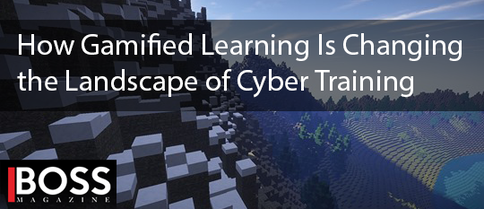









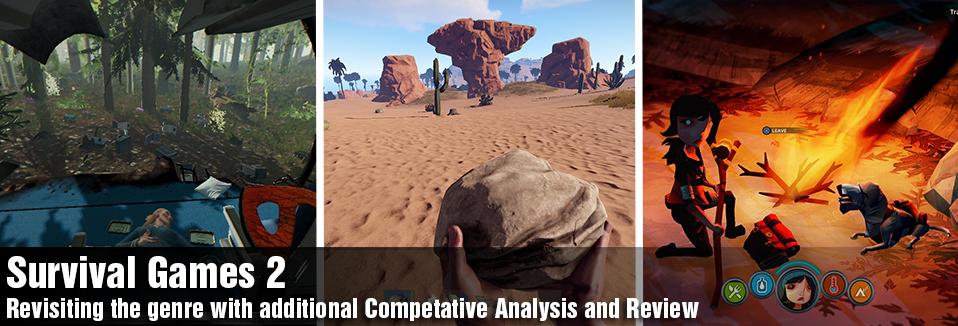

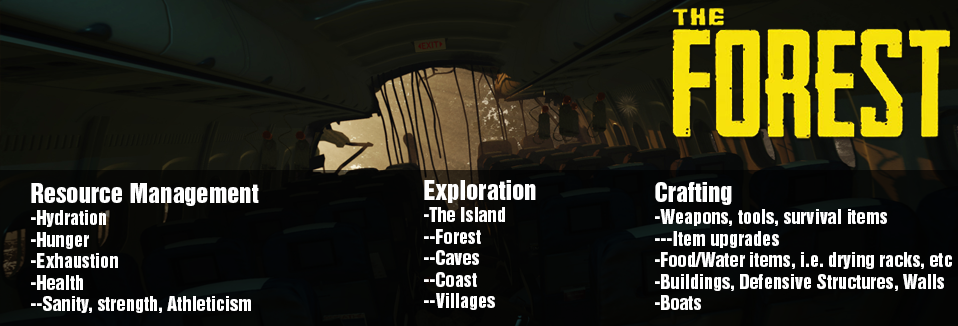

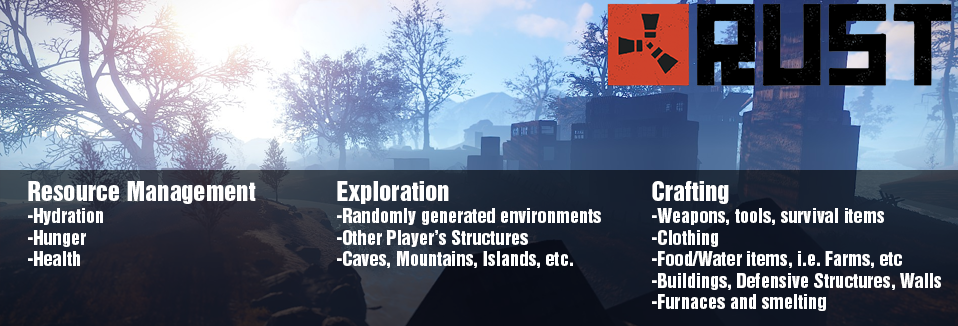
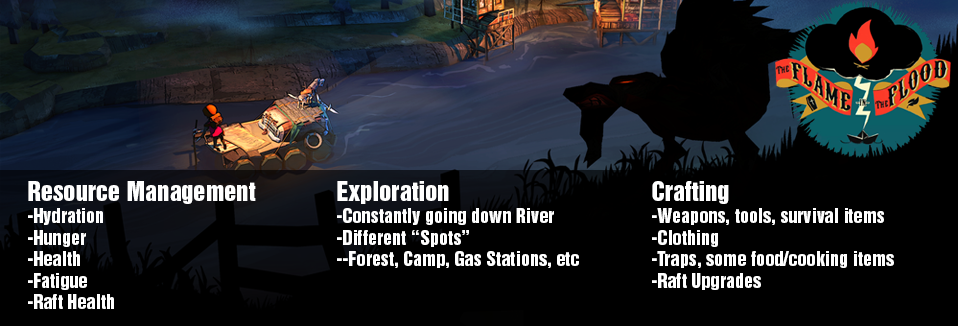
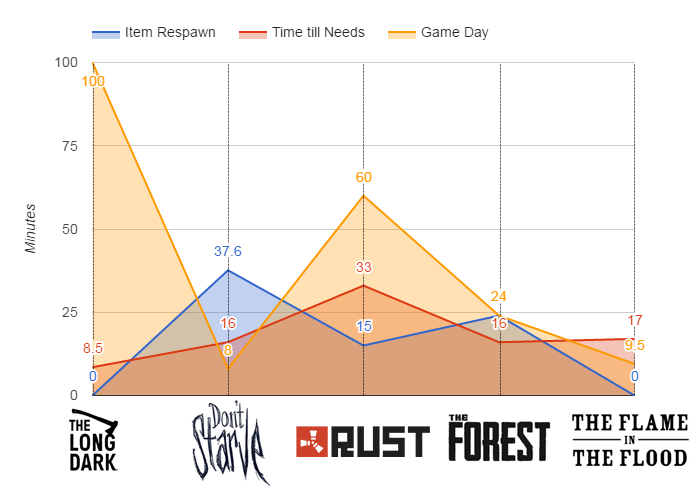

 RSS Feed
RSS Feed